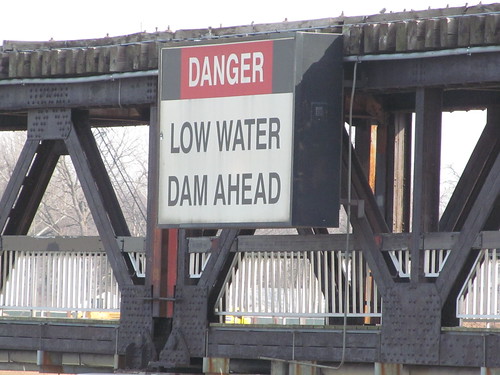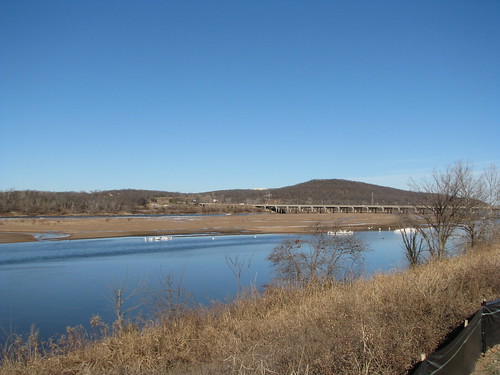Re-Vision: March 2016 Archives
North Tulsa residents are among the most skeptical of visionary sales taxes. They know that they will bear a heavy share of the costs, but they are doubtful of seeing any benefits. They'll pay extra sales taxes on the basics of life -- food, clothing, electricity, natural gas -- and the money will go to build play-places in well-to-do neighborhoods in midtown and south Tulsa. North Tulsans have seen their city swimming pools closed and filled in, their recreation centers torn down, and their streets fall apart, while the other side of I-244 seems to get everything fixed promptly.
Proponents of the Vision Tulsa Dam Tax are desperate to convince voters in the North Community that money for Gilcrease Museum ($65 million), the Tulsa Zoo ($25 million), and the airport ($27.3 million) constitute money to help develop the most economically distressed neighborhoods on the northside.
Yes, Gilcrease Museum is north of Admiral, as are the zoo and the airport, and they've been north of Admiral since long before I was born, and these are valuable institutions for our city, but they haven't generated nearby commercial development, much less improved conditions for the hardest-hit neighborhoods in north Tulsa, which are miles away from these institutions. To count the $117.3 million allocated to these institutions as money for north Tulsa economic development is disingenuous and shows contempt for the intelligence of North Community residents.
Earlier today, I emceed a press conference at Rudisill Library featuring the remarks several northside residents concerned about the lack of economic impact for their community in the Vision Tulsa Dam Tax proposal.
Sherry Laskey spoke of her impressions upon returning to her hometown last year after five years away. She recalled Vision 2025's passage in 2003, when her son was a toddler, and remembers the promises made about economic growth and the high hopes she had. She sees Archer Street as a a stark dividing line between development and infrastructure condition to the north and to the south. Thirteen years later her son is a teenager, and she sees that the physical and economic condition of the community has gone backwards. "Nothing has changed. Things have gotten worse. There's nowhere for our children to get a job once they graduate from high school."
Vanessa Hall Harper expressed her displeasure with the process used to select projects for the northside. An ill-defined project, devoid of specifics, called Peoria Connections was selected for funding in the package, while projects growing out of the thorough small-area planning process for the 36th Street North corridor (also known as the Phoenix District) were left on the cutting-room floor. Residents were told that the vague but more expensive Peoria Connections project (the pitch presentation consisted of a series of uncaptioned photos taken along the street) would be selected -- take it or leave it.
Ms. Harper said that "[the Greenwood Chamber of Commerce] held several forums right here in Rudisill Library. We asked the community to come in, and we showed them all of the presentations that were made before the City Council, and we asked the community to prioritize their top five projects. We sent that information to the Mayor and the City Council, and it was not even considered.... We are tired of being told what's going to happen after the fact." She said that the failure of City Hall to listen to the community's priorities was her primary reason for voting no on the "economic development" package.
Tracie Chandler is a leader in the North Star Neighborhood Association, which secured the funding to create the 36th Street North corridor plan and spearheaded the plan's completion and incorporation into the city's Comprehensive Plan. The city has already committed $8.5 million toward the plan's implementation in the Improve Our Tulsa package (the current Third Penny package).
"If you've got money, power, and influence, you got on the list." As an example of power and money, Ms. Chandler pointed to $65 million in tax dollars for Gilcrease, which also has $50 million promised from private funds. As for influence, Ms. Chandler noted the selection of the vague and more expensive Peoria Connection project over the 36th Street North proposal, which would have cost $5 million less than the Peoria Connection proposal and would have facilitated two miles of redevelopment from Lewis to MLK. "Could it be because of Councilor [Jack] Henderson's close ties to NTEDI [North Tulsa Economic Development Initiative], the organization that submitted the proposal? Does that sound like influence to you?" Ms. Chandler said that the Peoria Connection plan would have little to no economic impact, while the 36th Street small area plan would have tremendous impact, was detailed, and had been adopted unanimously by the City Council into the Comprehensive Plan.
"This is our money. People, we have the power. These committees, the councilor, the mayor -- they did not listen to us. This needs to be voted down. They need to come to the citizens and hear what we have to say. If we accept this, then we're saying that 'it doesn't matter that our voices weren't heard; walk all over us!' We need to be heard."
Later in the meeting, Ms. Chandler said she planned to write another editorial about her councilor's involvement in the project selection process, to be titled, "Vision Package: Judas Still Walks among Us."
Noting that there were a couple of items that northsiders would find positive (funding for Langston University's Tulsa campus and for a business park), Ms. Chandler emphasized, "For North Tulsa, this package is 94% rotten. So my question to you is this: Would you eat an apple that was 94% rotten just to get to the good part?"
I chimed in to mention the very back-handed "endorsement" of the "economic development" package by the Oklahoma Eagle. Ray Pearcey urged northsiders to vote for the dam tax, while agreeing substantially with Tracie Chandler's assessment of the many useless items in the package.
But we remain opposed to a passel of environmentally insensitive, economically incoherent or not particularly well thought out projects - including the proposed Arkansas River/Dam initiative and a bunch of other poorly defined or questionable items. But here's the bottom line - the economic package is like a grand, but oddly sourced salad - one that may have some tough seeds or even some nails in it - but if you want to eat the salad - you have to eat everything in the bowl.
Maybe that's Ray's way, but if I got a salad with nails in it, I'd send it back to the kitchen and find another restaurant. Voters need to send this salad back on April 5, and then we need to fire the chefs that tried to serve us a salad bowl full of shrapnel. I reminded the assembled press that the current Vision 2025 tax doesn't expire until December 31, and we have three more election dates between now and then when the City Council could present us with a sound proposal -- nothing but fresh veggies in the salad.
James Johnson, another lifelong north Tulsa resident, spoke up to note that city leaders were asking the poorest citizens to fund $65 million for Gilcrease and $25 million for the zoo, in exchange for a "$7 million parking lot for Mr. Kaiser," referring to the proposed industrial park. "If you're a north Tulsa resident, and if you vote yes on this Vision -- their Vision -- please take a look in your mirror and say to yourself, I'm the reason that north Tulsa looks like it does." He pointed out that there was more economic activity on 36th Street North in the 1980s than there is today. Referring to Mayor Dewey Bartlett's slogan of "One Tulsa," Johnson said, "Mayor Bartlett, are you serious? He's running around, popping his collar, and north Tulsa looks like it does. You know, my grandmother would say, he needs to cut three willow switches, bring them to me, and take his pants down, and let me put the three willow switches on him, because he's wrong."
Ms. Harper pointed toward the area's lack of a supermarket and the lack of street lights on the expressways. "When you're wanting to spend millions and millions of dollars on other projects when basic needs of the community are not being met, in my book that's frivolous spending. Let's meet the basic needs of every community first -- that's the purpose of our tax dollars -- and then let's move on to other projects."
Mr. Johnson reminded the audience that several city-owned recreation centers and swimming pools in north Tulsa were recently demolished; meanwhile the pool at McClure Park in east Tulsa was going to be rebuilt. "We've torn out all these parks in north Tulsa as if black children, children in north Tulsa don't matter." Ms. Chandler emphasized that there is nothing in the package for north Tulsa children.
Regarding the demolished pools and rec centers, I mentioned that back in 2003, many of these pools were closed because of budget problems and streetlights on the expressways were extinguished. We were promised that if we passed Vision 2025, we'd see enough economic growth to generate the revenues to reopen the pools, turn the lights back on, fix the streets, and hire more police officers. Vision 2025 was approved, and it built a lot of pretty things, but the economic growth never came, the pools were never reopened, and now we're being asked for a permanent 17.25% increase in our permanent sales tax rate to pay for basic city operational costs.
MORE:
After the jump, links to media coverage of the event, presentations and details of the two competing north Tulsa development proposals -- the one that was picked, and the one that was passed by, and links to and comments about the proposals for Gilcrease, the airport, and the zoo.
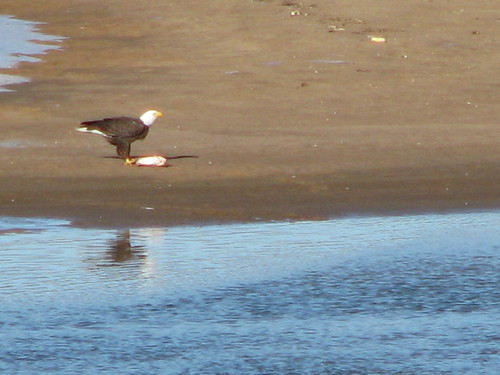
Over the last 13 years, I've written quite a bit about the Arkansas River and proposals for damming and remodeling it, and about what Tulsans really are seeking when they ask for water in the river. Recently I resurrected several of my Urban Tulsa Weekly columns and my 2007 cover story on the topic from Internet Oblivion.
Here's a selection of past BatesLine stories about river development. I especially recommend the first story, as it has lots of pretty pictures like the one above, and it reflects a change of heart on my part -- the realization that a low-water dam would be a bad deal even if it were given to us free, because of the beauty that it would cover up.
- September 2014: Turning the Arkansas River into Joan Rivers: The fascinating variety of wildlife, including bald eagles, that enjoy the sandbars that low-water dams would destroy.
- January 2007: The River Review: Planning Tulsa's Riverfront: A Brief History: Urban Tulsa Weekly cover story about the 100-year history of Tulsa's plans for river development.
- October 2006: A riverwalk promenade proposal: lower Elm Creek: A waterfront promenade connecting the 18th & Boston district to the river could be created by uncovering Elm Creek, which currently flows underground through giant stormwater pipes.
- October 2006: A promenade on the river: NYC's Bryant Park serves as the inspiration for amenities that could have turned the east bank from 11th to 21st Street into a lively place to see and be seen.
- September 2006: Wanted: A Promenade: When Tulsans say they want "river development," what are they really after?
- September 2006: River realities: The Arkansas, viewed from an airboat: Steve Smith, who operated airboat tours on the river, on how Tulsa should shape and use the river.
- August 2006: Making the most of Tulsa's unique places: The case for special design rules for the river corridor to ensure development that makes the most of this unique resource.
Here's a link to the complete archive of the Arkansas River category on BatesLine.
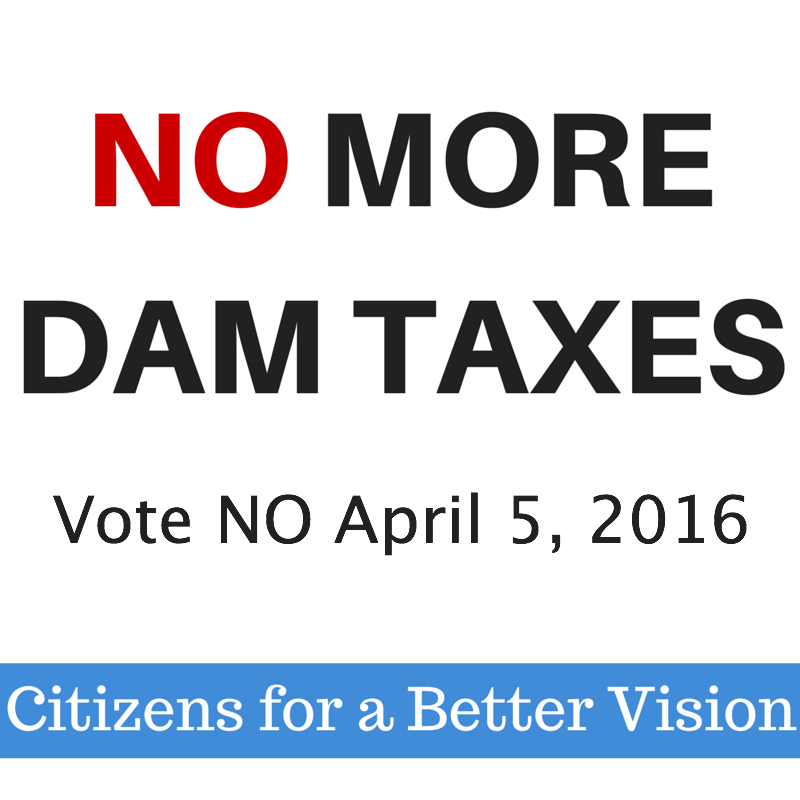 Among the many flaws in the Vision Tulsa dam tax proposal (on the April 5, 2016, ballot) are what I've decided to call the Payola Projects -- projects that involve giving a chunk of money to various institutions in hopes of winning their constituents' votes for the dam tax.
Among the many flaws in the Vision Tulsa dam tax proposal (on the April 5, 2016, ballot) are what I've decided to call the Payola Projects -- projects that involve giving a chunk of money to various institutions in hopes of winning their constituents' votes for the dam tax.
A Payola Project typically involves a suspiciously round sum of money which the city will transfer to another governmental entity (which often has its own source of funding). The amount of money may or may not be enough to pay for a specific construction project. They may not even have even a specific project in mind, or the project might be contingent on a string of approvals yet to be obtained. The important thing is for the target constituency of the Payola Project to think that the small amount of money they're getting is worth wasting $128 million on dams in the Arkansas River.
A Payola Project is all about symbolism over substance: "We haven't allocated enough money to do anything meaningful about this issue that matters to you, dear voter, but we want you to think that we care, so you'll vote for our Dam Tax."
On four separate occasions, voters have rejected taxpayer-funded low-water dams in the Arkansas River, but city mis-leaders like G. T. Bynum and Dewey Bartlett Jr. insist that they'll be a game-changer, so they're back on the ballot for a fifth time, surrounded by a collection of Payola Projects. Think of a Payola Project as an electoral flotation device for the big, expensive dam project, which would otherwise sink at the ballot box as fast as Luca Brasi in concrete overshoes sank in the East River.
The Payola Project for voters concerned about public education is listed this way in Title 43-K, the ordinance that (vaguely) regulates how money in Vision Tulsa Proposition No. 3 for "Economic Development" must be spent:
Public Schools - Partnership with Union, Jenks & Tulsa Public Schools in Teacher Retention, Recruitment, and Training Efforts: $10,000,000
(I wonder why they didn't include the rest of the public school districts that serve the City of Tulsa: the Broken Arrow School District, which serves growing new Tulsa subdivisions southeast of 31st and 145th East Ave, or Catoosa School District, which serves recently annexed areas in Wagoner County.)
Here's how Tulsa City Councilor and former Tulsa school board member Anna America answered a question about the project on March 24 -- a mere 12 days before the election, showing the vague and unsettled state of the proposal
Jeff, we are still working on the final details. The original proposal was for $50 million for two pieces -- housing incentives that could be used for homebuyers or renters, and stipends for continuous learning in the summer. It was scaled back to $10 million, so we are discussing exactly how that would look -- my hope that we do it in the way that has the most impact with the most teacher. There has been some discussion of using the housing part in conjunction with some property the city owns to create a "teacher town" but there are a lot of moving pieces on that., so it may not work out. This was the document submitted as part of the orignal proposal (although it looks to me like they issed a page in the scanning) and we will bascially be doing a scaled back version, although we purposefully took out language specific to housing and made it "attraction and rettention" so we have more flexibility on allowing the district use the money for other kinds of incentives for teachers.. https://www.cityoftulsa.org/media/432235/Teach-Live-T-Town-Presentation.pdf
According to State Department of Education reports the Tulsa district had, in school year 2014-2015, 3,118 teachers, Jenks had 819, and Union had 1,109. That's a total of 5,046 teachers. If you divided that "attraction and rettention[sic]" bonus among those teachers for the 15 years of the tax, it would amount to $132.11 per teacher per year, or about 73¢ per instructional day. It's better than a poke in the eye with a sharp stick, as my grandma used to say, but it wouldn't buy a decent cup of coffee, and it's hard to see how that will succeed in attracting or retaining anyone who isn't otherwise determined to be here.
Voters who care about funding for public education ought to lobby the legislature or petition to raise the cap on the local property tax levies for schools or to find some other local basis for increasing funding if local voters want to do so. Voters who care about attracting and retaining teachers should lobby their school boards to reduce the administrative burden so that funds already available to the school will go to the classroom instead.
Keep in mind that you have the option of voting yes or no on four different propositions on April 5. Keep in mind that the current Vision tax doesn't expire until December 31, 2016. There's plenty of time for the City Council to develop a sound plan, and three more opportunities this year to put it before the voters.
If you care about funding for public education, you should vote down Proposition 3, which includes this insulting attempt at a bribe, and tell the City Council to put together a better plan.
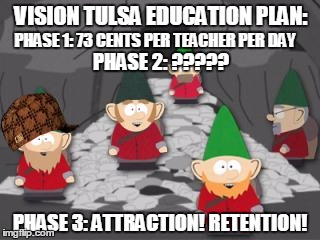
Vision Tulsa Vote Yes ads claim (dishonestly) that approval of the Vision Tulsa Dam Tax hike on April 5, 2016, will prevent future strip malls from being built along the river. In fact, nothing in the Vision Tulsa propositions address development standards. Moreover,
the City Council has the power right now to prevent inappropriate development, both through the zoning ordinance and through placing conditions on the sale or lease of city-owned land. Far from helping protect the river corridor, voter approval of the proposed Vision Tulsa Dam Tax would instead surrender the only financial leverage Tulsans have to push for common-sense rules to ensure appropriate future development along the Arkansas River.
The City Council has had the power all along to amend the zoning ordinance to require appropriate and compatible development along the river. The City Council could create a new zoning district along the river and specify design guidelines for any new construction within the district. If the design guidelines are sufficiently objective, they could be enforced directly through the permitting process. If the design guidelines involve a degree of subjective judgment, the ordinance could require that applications for construction be approved by a design review board before a building permit is issued. While this cannot be done overnight -- the Tulsa Metropolitan Area Planning Commission would have to review such an ordinance and make a recommendation before the City Council could act -- it can be done. We have an example just down the turnpike.
Oklahoma City has numerous design-focused zoning overlay districts; many of them have been in place for over 30 years. Some are intended to preserve the walkable, urban characteristics of historic commercial districts like 23rd Street and Classen Blvd. Some are aimed at ensuring that new development is compatible with existing development in a neighborhood. Two districts, established in 2007, specifically deal with the banks of the North Canadian River (aka "Oklahoma River"): The Scenic River Overlay District and the Scenic River Overlay Design District.
It's not as though the need for design guidelines along Tulsa's riverfront has suddenly arisen. Starting around ten years ago, chain restaurants, a shopping center, and a convenience store were built on the west side of Riverside between 96th Street and 101st Street. All of these buildings turn their backs to the river, and most are typical cookie-cutter, chain-store architecture, a huge waste of the unique opportunity presented by the river (sandbars or no sandbars). That nothing has been done to date leads me to believe that nothing would be done once the Council has secured the dam tax increase.
(MORE: In an August 2006 column, I explained why design guidelines were appropriate for unique places like riverfronts and the gateways to our city. In February 2007, then-Mayor Kathy Taylor called for a study of special zoning for the river corridor, but as far as I can tell, the effort never went beyond the discussion phase.)
City leaders have even more control over riverfront development when the project requires the use of publicly-owned land. And yet our current mayor and council seem determined to discard that leverage.
Back on August 11, 2015, the Tulsa Public Facilities Authority (TPFA) voted 3-2 to sell the northern section of Helmerich Park, a city park along the Arkansas River southwest of 71st and Riverside, to a commercial developer for the construction of a strip mall and large parking lot.
Just a few weeks earlier, on July 16, 2015, the City Council voted to change the comprehensive plan land-use designation for the parcel from "Park and Open-Space" to "Mixed-Use Corridor" and from "Area of Stability" to "Area of Change." This greased the path for any zoning accommodation that the developers might need. A no vote by the Council may well have deterred the developer from pursuing the shopping center.
A lawsuit challenging the TPFA's authority to sell city-owned land without the blessing of the City Council has put the sale on hold, but there are reports that proponents of the sale have found a way around this roadblock, and that this will be under discussion at a meeting of the TPFA this Thursday, March 31, 2016, 4:30 p.m, in Room 10-203 at City Hall. (The meeting notice is online, but the agenda has not yet been posted.) The way around the roadblock? If the City Council votes to abandon the section of the park as surplus to the city's needs, the lawsuit would be moot, and TPFA would have permission to move ahead with the sale to the developers.
Former Tulsa Mayor Terry Young has been a leader in the effort to stop the commercial development of the northern half of Helmerich Park. Late last week his alert was posted to the Save Helmerich Park Facebook page:
URGENT NOTICE!Helmerich Park Friends:
The Tulsa Public Facilities Authority has scheduled a new Special Meeting to act on a request to the City Council to ABANDON parts of Helmerich Park.
The request to ABANDON a tract in the park is to allow the sale of the land to private developers for the construction of a 52,000 square foot shopping center and acres of asphalt parking.
WE NEED HELMERICH PARK SUPPORTERS TO ATTEND THIS MEETING TO RAISE DEEP CONCERNS ABOUT THIS ACTION!
The meeting will be:
Thursday
March 31, 2016
4 p.m.
Room 10-203 (Tenth Floor)
City Hall - One Technology Center
175 East 2nd StreetPlease mark your calendar and try to attend. Bring other supporters. This board needs to know the depth and breadth of our opposition.
Here is what is at stake:
In response to our lawsuit which makes it clear that TPFA does not have the power to sell any or all of Helmerich Park, TPFA is planning to ask the City Council to do it by:
Passing a resolution abandoning the park use of a portion of Helmerich Park and finding it is no longer needed for public use.PLUS:
TPFA will ask the City Council to:
Endorse, support, and consent to the sale of Helmerich Park to North Point Property for building a shopping center.
We have a full week to add this meeting to our respective schedules.
I hope you will join us to add many, many more faces to our efforts to sway TPFA and to SAVE HELMERICH PARK.
Terry Young
Here is a timeline of statements made by Muscogee (Creek) Nation (MCN) elected officials regarding their financial involvement in the low-water dam. When you clear away the wish-casting statements being made by city officials, you'll notice that there aren't any MCN officials offering money to the project. Instead, MCN officials merely acknowledge that city officials are asking for MCN money for the south Tulsa/Jenks dam, and MCN officials note the large amount of money the tribe has already put into development along the river and the unmet economic needs of Creek citizens living on the southern end of the nation's territory.
So why don't Creek officials go ahead and rule out financial support for the south Tulsa/Jenks dam, regardless of the outcome of the April 5 vote? I suspect they would prefer not to be the "bad guy." If the proposition fails in Jenks or in Tulsa, as seems likely, Creek financial contribution will be moot, without Creek officials having to be the ones to say no. If the proposition passes, they can offer some token amount of money, figuring that Tulsa officials will be so anxious to satisfy the "memorandum of understanding" requirement in the Brown Ordinance for Proposition 3 (Title 43-K), that they'll take anything. Here's the actual language that ties the south Tulsa/Jenks dam to MCN involvement. Note that there's no minimum amount that Jenks and MCN have to contribute:
The project entitled 'South Tulsa/Jenks Lake and Related Amenities' is contingent on additional funding for other aspects of the entire project, to be provided by the City of Jenks and the Muscogee (Creek) Nation, including a long-term operating and maintenance endowment. If a Memorandum of Understanding is not executed by all three funding partners on or before December 31, 2016, funding allocated by the City of Tulsa for this project ($64,214,000) will be reallocated according to the provisions of this ordinance, provided that Eighteen Million Dollars ($18,000,000) will first be reallocated to a long-term operating and maintenance endowment for Zink Lake and Related Amenities.If other projects and purposes described in Section 100(B) above cannot be completed due to circumstances beyond the control of the City of Tulsa, funding allocated for such projects and purposes will be reallocated according to the provisions of this ordinance.
Many of these quotes come from the Muscogee Nation News, the bimonthly print publication that serves as "the official tribal newspaper of the Muscogee (Creek) Nation." Many of the articles that appear in the print edition were first posted to the Muscogee Nation News Facebook page.
Last week, a local TV station spiked a well-researched news story about funding problems for the proposed south Tulsa / Jenks low-water dam and the awareness of Tulsa elected officials of the problem before they voted to put the proposal on the ballot. The story's sudden withdrawal hints at pressure by local power-brokers, panicked that the public will become aware of the flimsy foundation of the "Vision Tulsa" sales tax proposal. Tulsans will vote three proposed new city taxes and a new county tax up or down in an April 5, 2016, special election.
An extensive 1163-word news story by reporter Rick Maranon about the Muscogee Creek Nation's refusal to commit to funding for maintenance of the dam was posted to Fox23.com last Tuesday evening, March 15, 2016, then was deleted from the website later the same evening. While long website news stories are typically transcripts of video reports airing on Fox23's nightly news cast, no such story was aired.
The story cites a letter from Muscogee Creek Nation officials to city leaders, panicked emails among city officials about the implications of the MCN letter, video of council committee meetings, and other sources of information. Reporter Rick Maranon did a solid job of connecting the dots. Here's one of the more damning excerpts from the story:
FOX23 has reported numerous time within the past year that current and past city officials have stated the current state of the Zink Dam in Tulsa is the result of a lack of proper maintenance funding, and they wanted to set up an endowment so the current disrepair of the dam wouldn't happen again.City officials long assumed that the Creek Nation would be more than willing to pick up the tab because of their properties along the river involving Riverspirit Casino and the Flying Tee.
But after FOX23 reported that the Creek Nation was going to set up an endowment, members of the Creek Nation began to contact FOX23 saying they were not aware of the multi-million dollar commitment Tulsa officials had allegedly assumed they would be fine with.
The tribe's own internal news agency quoted Creek Nation representatives to Tulsa as saying they were not informed of the plan to set up the endowment and partner with Jenks and Tulsa on the dams.
Multiple sources close to the Vision Tulsa project who have been asked not to be identified have simply said city leaders assumed the tribe would be on board without consulting them of their plans before they presented them to voters as a done deal set in stone.
The first officials meeting to discuss an endowment happened on February 11th, and days later, the tribe officially notified city leaders they were out of the Vision low water dam plan....
On February 23rd, Tulsa City Council Vice Chair Anna America stated in an e-mail to councilors, "I think we need to make that clear to the public ASAP, and not try to be ambiguous at the press conference or in any other comments."
She went on to state in the same e-mail," I don't want to wait that long to say there won't be a south Tulsa dam if the Creeks say today they aren't participating in funding this year."
But the request appears to have fallen on deaf ears because two days later on February 25th, Tulsa city leaders launched the Vision Tulsa campaign stating that two low water dams would be built on the Arkansas River if the proposal is approved April 5th.
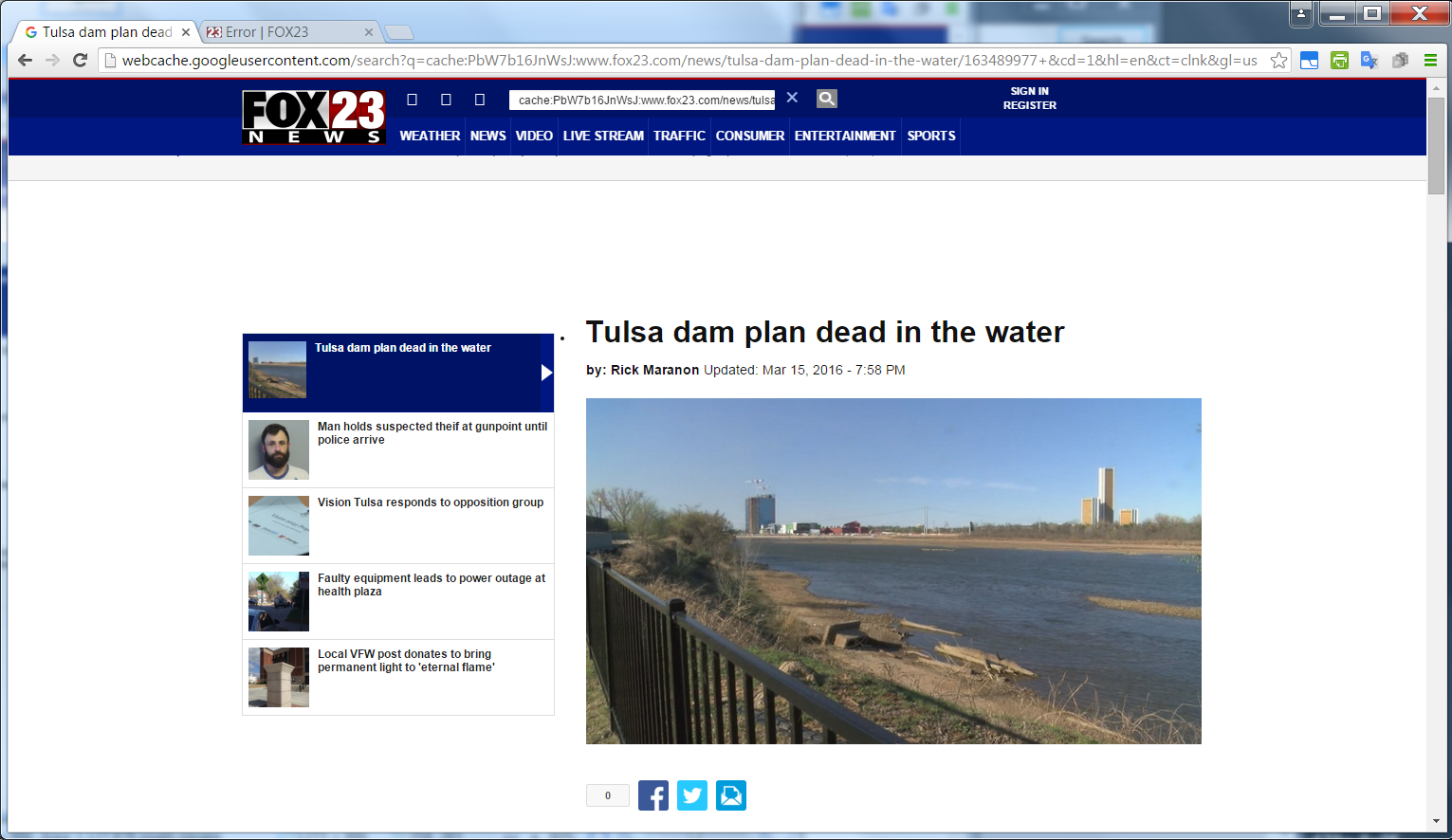
On Tuesday, March 15, 2016, at 7:58 pm CDT, Fox23 posted the detailed, 1163-word news story, headlined "Tulsa dam plan dead in the water"
The article was posted at the following URL, which now leads to a "404" page.
http://www.fox23.com/news/tulsa-dam-plan-dead-in-the-water/163489977
A person who saw the story on the Fox23 website when it was live reports that it was offline soon after.

As of Saturday, March 19, 2016, at 7:00 pm CDT, however, the story was still available in the cache of the Bing search engine and cache of the Google search engine captured by Bing when they crawled the page during its brief time in existence.
For posterity, I printed both cached versions of the story to PDF, using the Chrome browser's simplified print option.
Here is a PDF of Bing's cache of Tulsa Dam Plan Dead in the Water.
Here is a PDF of Google's cache of Tulsa dam plan dead in the water.
Other automated web-content harvesters captured portions of the story:
Places to Go in Tulsa: Tulsa dam plan dead in the water - KOKI FOX 23
KOKI FOX 23
According to multiple documents, including internal e-mails, Tulsa city leaders knew the south Tulsa-Jenks dam had fallen through, yet Tulsa city leaders not only kicked off their Vision Tulsa campaign in late February as if nothing had happened, they ...
Dams Infrastructure News: Tulsa dam plan dead in the water | FOX23 - KOKI FOX 23
KOKI FOX 23
Tulsa dam plan dead in the water | FOX23
KOKI FOX 23
A plan to build a low water dam on the Arkansas River in the south Tulsa-Jenks area is dead. The Muscogee Creek Nation said they do not have the funds to ...
and more »
So what happened? Fox23 isn't commenting on the story's disappearance, but it's reasonable to speculate based on behavior by Vote Yes forces in past big-project sales tax elections. I have reason to believe that Vision Tulsa supporters threatened to pull advertising, threatened to cut off any cooperation by city officials on future Fox23 stories, and threw some confusing but irrelevant information at station officials at the last minute -- confusing enough to convince station officials to hold off on the story until more research could be done.
Happily, the story's brief appearance online has pointed other news organizations to the sources of information that Maranon uncovered, and now Jarrell Wade of the Tulsa World has a front-page story today on the Creek Nation's unwillingness to fund the dam. We look forward to further coverage of the story, and we'll also post the full text of the relevant public documents and offer further comment here at BatesLine in the days to come.
We can hope that Fox23 management will realize that they were played by the Vote Yes forces and lost a great scoop as a result, spiking a story that reflects serious journalistic effort and investigative depth. May it only make the Fox23 team more aggressive in exposing dishonesty, obfuscation, and misdirection by public officials.
The Tulsa County Republican Men's Club is hosting a forum tonight, Tuesday, March 8, 2016, at 7:00 p.m., about the upcoming April 5 vote on the "Vision Tulsa" tax propositions. George McFarlin and I will be there to explain why you should vote against the propositions. I understand that there will be some Vote No yard signs available to opponents, for a donation to cover the cost.
The format of the event keeps changing, as the Vote Yes side has dithered about what format they consider acceptable and whether they will participate at all. This is typical behavior in every tax proposal: The Vote Yes side knows that their case is weak, and they try to limit any opportunity for the Vote No side to be heard, particularly in a debate format where questions may be asked that the proponents would rather not answer. The Vote Yes side will refuse to participate in a forum or debate and then pressure the hosting organization into not holding the event because it wouldn't be fair for only one side to be represented. I'm happy to say that many radio and TV stations and civic organizations are no longer taken in by that argument; they insist that the event will go forward under their rules, whether the Vote Yes side chooses to participate or not. When faced with a resolute debate host, the Vote Yes side will comply more often than not.
In any event, we'll be there and will be prepared to answer specifics about each proposition and project as well as explain why we think "Vision Tulsa" is myopic and a bad deal for Tulsa.
UPDATE:
Many thanks to the Tulsa County Republican Men's Club for setting up this forum, to KRMG for mentioning it on the air, and to KTUL for coming out to talk to some of us for a story that aired this evening.
TCRMC worked with members of the City Council to get someone to this meeting to speak in favor of the tax propositions, but none of them showed up. David Schuttler put together a video highlight reel of the meeting. I didn't take a head count, but I think about 30 people were in attendance.
A former councilor, Skip Steele, who used to represent District 6 in east Tulsa, showed up, and he didn't like what he heard. He didn't care for my statement that Vision 2025 failed in its stated mission of economic development. I pointed out that we were promised that if we passed Vision 2025 it would create enough new economic activity through the convention business and tourism that we would have more local sales tax revenues to spend on basic city services like public safety and streets. It manifestly did not work, because now the city is asking is to pass a 17.25% increase in our permanent sales tax rate to cover basic operating expenses. If Vision 2025 had succeeded in growing the economy as promised, retail sales would have gone up so much we wouldn't need to increase the permanent sales tax rate.
Steele also took exception to our statement that the police and fire departments currently use up 100% of the revenues the city derives from the permanent 2% sales tax (an insight first brought to our attention by then-Councilor Bill Martinson in 2009), and that there were other sources of revenue coming into the general fund that pay for non-public-safety expenses.
The facts backed us up. According to page 3-7 of the FY2016 City of Tulsa budget document, in FY2014 (the most recent year for actuals), the city's general fund received $145,998,000 in sales tax revenues. That same fiscal year (page 3-9), the city spent $156,534,000 on Public Safety and Protection, which includes Police, Fire, Municipal Court, and Emergency Management. That's 107% of the revenue from the 2% sales tax.
Beyond the 2% permanent sales tax, the general fund also received revenues from the city's use tax, franchise fees from ONG, PSO, Cox Cable, and the Right of Way Occupancy Fee, hotel/motel taxes, licenses and permits, shared revenue (liquor tax apportionment, gasoline tax, tobacco tax, vehicle license), intergovernmental revenue grants and reimbursements, payments from trust authorities for general government support services, code enforcement fines and fees, PAC revenue, park revenue, fines and forfeitures, airport fire reimbursement, interest income, miscellaneous revenue, and transfers in from other funds. In FY2014, the general fund received $261,176,000 in total annual resources. There's a pie chart on page 3-5 showing how much revenue comes from each category. General fund outlays were $257,709,000 (page 3-11).
Another point that bothered Steele -- something that was incidental to the main topic -- was a reference to property taxes as city revenues. He said the city couldn't draw on property taxes. A gentleman in the audience emphatically pointed to his property tax statement which showed a little over 16% going to the City of Tulsa. George McFarlin pointed to corroborating information on his property tax statement. While it's true that the city can't use property taxes for operating expenses, the city has a millage, which feeds a sinking fund, which pays for legal judgments against the city and for debt service on our general obligation bond issues. Each year the county excise board looks at the city's sinking fund obligations and calculates the millage required, based on the valuation of all the taxable property in the city limits, to meet that obligation.
George and I will be on Talk Radio 1170 KFAQ on Wednesda, March 9, 2016, with Pat Campbell and Eddie Huff to discuss Vision Tulsa and No More Dam Taxes. If you don't have an AM radio handy, listen live online.
If you take time to read the Vision Tulsa ballot resolutions and ordinances that define the new city sales tax rate and control how the new city sales taxes will be spent, the barrage of changing tax rates and effective dates may make your head swim. That's why I put together an infographic to help me visualize those changes. This infographic revealed a trap, a hidden tax hike that Dewey Bartlett Jr., G. T. Bynum IV, and the rest of the City Council hope you overlook.
Proponents claim that Vision Tulsa won't increase the overall sales tax rate, but there's a hidden trap in Proposition 3 that will force voters in 2021 to accept a hike in the overall tax rate in order to continue the longstanding "Third Penny" for streets and other basic infrastructure.
This chart shows the current allocation of City of Tulsa and Tulsa County sales taxes, with the proposed changes on the April 5, 2016, ballot highlighted with a heavy black boundary. Blue regions are permanent taxes for operations, orange regions are temporary taxes primarily for basic infrastructure capital improvements like streets and sewers, purple regions are "vision" taxes primarily for amenities and "economic development." City taxes are shown with darker shades, county taxes with lighter shades.
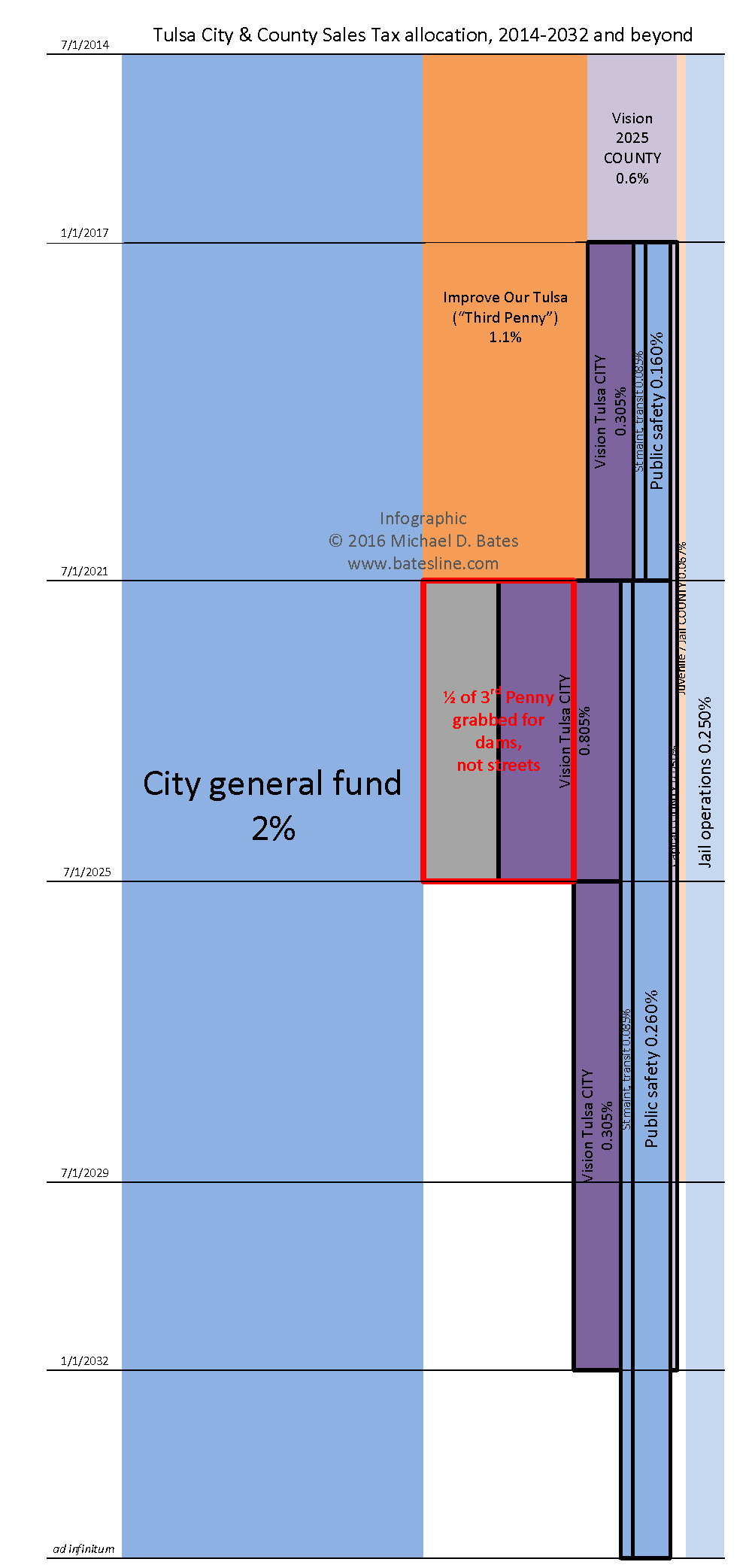
Tulsa County's "Vision 2025" 0.6% sales tax expires at the end of 2016. The City of Tulsa is proposing a combination of temporary and permanent taxes that begins at 0.55% for 4½ years, climbs to 1.15% for 4 years, shrinks back to 0.65% for 6½ years, and then leaves a permanent increase of 0.345%. Tulsa County is proposing a 0.05% increase for 15 years.
Starting in 1980, Tulsa citizens have approved a series of temporary sales taxes, earmarked for streets, reservoirs, sewers, stormwater system, and other fundamental city infrastructure. Because the original tax was an additional 1% levied on top of the 2% sales tax for the city's general fund, it became known as the "Third Penny."
The current "Third Penny" is 1.1% and it expires on June 30, 2021. If Vision Tulsa passes, it will grab a half-penny from that expiring "Third Penny" and put it toward Proposition 3, which includes building two new low-water dams in the Arkansas River. Another 0.1% from the expiring tax will go to increasing the permanent tax for public safety operational costs. That leaves only a ½ penny for a new streets package.
That four-year bulge in the Vision Tulsa tax amounts to $160 million that won't be going to rebuild our crumbling streets. Instead, that's just about what it will cost to build two new dams in the river.
If we VOTE NO on APRIL 5, the Council can eliminate the dams and a couple of other wasteful projects, and thus eliminate that four-year, ½-penny bulge in the Vision Tulsa tax, before sending it back to us for another vote. That would leave room for our traditional "Third Penny" for streets and basic infrastructure to be extended as usual in 2021 without an overall tax increase. To make that happen, we have to VOTE NO ON APRIL 5.
MORE:
Here is a PRINTABLE VERSION of the Tulsa sales tax timeline that you can download and hand out to your friends.
Infographic and text Copyright 2016 by Michael D. Bates. Limited license granted to opponents of Vision Tulsa to copy and distribute without alteration prior to April 6, 2016.
